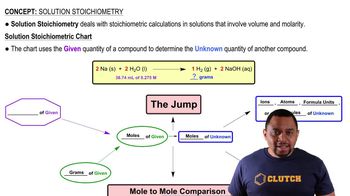The following figure represents solutions at various stages of the titration of a weak acid, HA, with NaOH. (The Na+ ions and water molecules have been omitted for clarity.) To which of the following regions of the titration curve does each drawing correspond: (b) after addition of NaOH but before the equivalence point? [Section 17.3]

(a) Will Co(OH)2 precipitate from solution if the pH of a 0.020 M solution of Co(NO3)2 is adjusted to 8.5? (b) Will AgIO3 precipitate when 20 mL of 0.010 M AgNO3 is mixed with 10 mL of 0.015 M NaIO3? The Ksp of AgIO3 is 3.1 * 10^-8.
 Verified step by step guidance
Verified step by step guidanceKey Concepts
Solubility Product Constant (Ksp)

pH and Precipitation

Stoichiometry of Mixing Solutions

Match the following descriptions of titration curves with the diagrams: (a) strong acid added to strong base. [Section 17.3]
Match the following descriptions of titration curves with the diagrams: (d) strong base added to polyprotic acid. [Section 17.3]
The following graphs represent the behavior of BaCO3 under different circumstances. In each case, the vertical axis indicates the solubility of the BaCO3 and the horizontal axis represents the concentration of some other reagent. (a) Which graph represents what happens to the solubility of BaCO3 as HNO3 is added? [Section 17.5]
Ca1OH22 has a Ksp of 6.5 * 10-6. (b) If 50 mL of the solution from part (a) is added to each of the beakers shown here, in which beakers, if any, will a precipitate form? In those cases where a precipitate forms, what is its identity? [Section 17.6]
Three cations, Ni2+ , Cu2+ , and Ag+, are separated using two different precipitating agents. Based on Figure 17.23, what two precipitating agents could be used? Using these agents, indicate which of the cations is A, which is B, and which is C.[Section 17.7]
